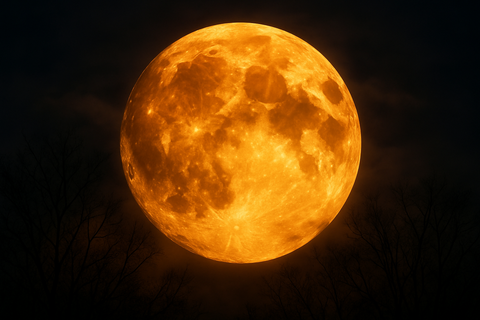
Moons and the Countryside
The Hunter Supermoon: Nature's Brightest Timekeeper
For centuries before electric lights illuminated our nights, people in the countryside lived by the rhythms of the sun and moon. These celestial bodies were more than just beautiful sights in the sky—they were essential tools for tracking time and planning the work that sustained rural communities. Among the year's full moons, few hold as much significance for country living as October's Hunter's Moon, especially when it becomes a spectacular supermoon.
Understanding the Moon's Monthly Journey
Every 29.5 days, the moon completes a cycle from new moon (when we can't see it) to full moon (when it's completely illuminated) and back again. Our ancestors named each full moon based on the seasonal activities or natural events occurring at that time of year. These weren't just poetic names—they were practical reminders of what needed to be done to survive and thrive.
What Makes a Supermoon Super?
The moon doesn't orbit Earth in a perfect circle. Instead, it follows an oval path, which means sometimes it's closer to us and sometimes it's farther away. When a full moon happens to occur while the moon is at or near its closest point to Earth (a position astronomers call "perigee"), we get what's known as a supermoon.
A supermoon can appear up to 14% larger and 30% brighter than when the moon is at its farthest point. While you might not notice the size difference with your naked eye, you'll certainly notice how brilliantly it lights up the night sky—and this extra brightness made all the difference for our rural ancestors.
The Harvest Moon and Hunter's Moon: Autumn's Essential Pair
To understand the Hunter's Moon, we first need to talk about its predecessor: the Harvest Moon. This is the full moon closest to the autumn equinox (usually in September). During harvest time, farmers worked desperately against the clock to bring in their crops before autumn rains or early frosts could ruin them. The Harvest Moon provided crucial extra hours of light, allowing work to continue well after sunset.
The Hunter's Moon follows immediately after, rising in October. By this time, the fields had been cleared and cut down, leaving them bare and open. This is where the Hunter's Moon earned its name and importance in the countryside.
Why the Hunter's Moon Mattered
In rural communities, October was the traditional time for hunting, and the Hunter's Moon made this essential task far more productive:
Visibility in the Fields: With crops harvested and vegetation dying back, animals that had been hidden all summer were now exposed. Deer, foxes, and other game animals stood out clearly against the bare fields, and the bright moonlight made them visible even at night.
Extended Hunting Hours: Just like farmers used the Harvest Moon's light to extend their working day, hunters used the Hunter's Moon to track and hunt game during the cooler evening and early morning hours when animals were most active.
Preparing for Winter: This wasn't sport hunting—it was survival. Country families needed to stock their larders with preserved meat to last through the long winter months. The Hunter's Moon's timing was perfect for this crucial task, as the cooler October temperatures helped preserve the meat.
Fattened Game: By October, animals had spent the summer and early autumn feeding abundantly. They were at their heaviest and healthiest, providing maximum nutrition for families preparing for winter's scarcity.
The Magic of Moonrise
Both the Harvest Moon and Hunter's Moon have another special quality that made them particularly valuable. Unlike other full moons throughout the year, these autumn moons rise at nearly the same time for several consecutive evenings—shortly after sunset. This happens because of the shallow angle of the moon's orbit relative to the horizon during autumn.
For people in the countryside, this meant several nights in a row of bright moonlight during the early evening hours—the most useful time for outdoor work. Instead of moonrise being delayed by 50 minutes each night (as it typically is), the delay during these autumn moons might only be 20-30 minutes, providing consistent, reliable lighting.
When the Hunter's Moon Becomes a Supermoon
When October's Hunter's Moon coincides with the moon's closest approach to Earth, creating a Hunter Supermoon, the effect is spectacular. The already bright and useful moon becomes even more luminous, casting sharp shadows and illuminating the countryside with an almost ethereal glow.
For modern country dwellers, a Hunter Supermoon is a breathtaking sight. For our ancestors, it was a gift—extra light for the essential work of putting food by for winter, nature's way of extending the productive day when it was needed most.
The Timekeeping Connection
At Wagstaff Watches, we appreciate how humanity has always sought to measure and understand time. The monthly cycles of the moon represent one of our oldest forms of timekeeping—"month" itself comes from "moon." The named full moons, like the Hunter's Moon, show how our ancestors connected timekeeping with the practical rhythms of rural life.
While we now rely on precise mechanical and digital timepieces, there's something profound about looking up at October's bright supermoon and knowing that countless generations before us looked at that same moon, used its light for the same purposes, and understood time through these natural cycles.
Experiencing the Hunter Supermoon Today
Even if you're not hunting or harvesting, the Hunter Supermoon offers a connection to these rural traditions. On a clear October night when the supermoon rises, take a moment to step outside. Notice how bright it is—bright enough to see clearly without artificial light. Imagine what it meant to people who depended on this light for their survival.
Whether you're in the countryside or city, the Hunter Supermoon reminds us that time is more than what we read on our watch faces. It's written in the sky, in the seasons, and in the traditions of those who lived close to the land.
The next time you see that brilliant October moon rising over the horizon, you'll know you're witnessing one of nature's most ancient and practical timepieces—still keeping time, still lighting the way, just as it has for thousands of years.










Comments (0)
There are no comments for this article. Be the first one to leave a message!